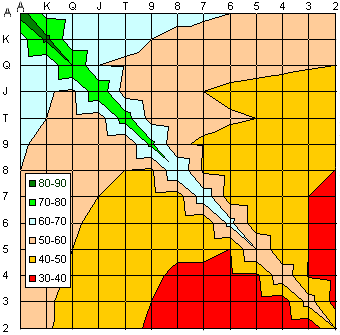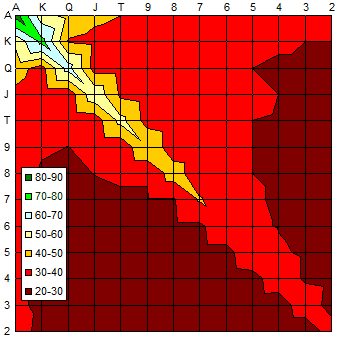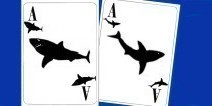Join our Newsletter & get our free guide Starting Hands Revealed
We hate spam too!
We value your privacy and never share your email.
All our emails have an opt-out link.
Click it, and you will never hear from us again.


|
Thursday, Dec. 18, 2008 - by Maurice Lefort
Texas Hold'em Starting Hands

This article discusses starting hand charts for advanced No-Limit Texas Hold'em Poker players. Any experienced poker
player knows that a starting hand chart is just a "reference".
As a skilled player, you understand that the way you play preflop depends on a number of factors. Of
course it depends before all on the number of players at the table.
Then, for a specific table situation, your preflop actions depend on your position and on what the players before you did.
In a ten-handed game, the first 3 players to act preflop are said to be in early position (EP), the next 3 are in
middle position (MP), the next 2 i.e. the cutoff and the button are in late position (LP), and the remaining 2 are the blinds.
Your starting hands should also depend on how loose or tight the table has been, if there any
noteworthy players such as a maniac or two, the styles of the players near you, etc. In addition, it depends on you
own style.
Two different charts, one tighter one looser could be both profitable. There is no unique chart. So all information
in this article is just a reference for advanced players, who need to add flexibility, judgment and opportunistic plays.
Reference Starting Hands EV
Let me start with a chart that shows the expected value of all hands against a random hand. In the chart below,
I show the probability of winning for all hole cards. The x-axis is your first card, the y-axis your second card, and the upper
triangle corresponds to suited cards while the bottom triangle is offsuit.
Note that the two diagrams below should be read by looking at the grid's crossing points. Pick a card from the x-axis and
one from the y-axis and the crossing point's color is the probability range for that hand.

The best hand is a pair of aces which has 85% chance of winning preflop against a random hand, while the worse hand
is 32 offsuit which wins 32% of the time. Thinking about it, even the worse hand can win about one time out of three.
The result is shown as a heating map, best combination in darker green, then lighter green, etc, and the worse hands are in red.
The chart shows that high pairs are very strong, followed by medium pairs and top aces or kings. The difference between suited
and offsuit combinations is not visible on this graph, as on average suitedness just adds a few percent chance of winning to the
corresponding offsuit hand.
Another Reference Starting Hands Map

The next charts shows the same probability of winning for hole cards, but instead of simulating versus any two cards, this time the test
is run against the starting range {66+, AQ+, AJs, KQ}.
This rather tight range better reflects what type of hands you may be facing in a real game. I used the same coloring
scale but I had to add one color, dark red for hands with less than 30% chance of winning.
The overall shape is similar, but what stands out is that the majority of hands are in red, meaning that they have less than 40%
chance of success. The strength of the strongest hands is much steeper, with big pairs and top aces dominating everything else by far.
Starting Hands Chart
Many factors influence how you should play preflop. I show below a reference list on how to play starting hands,
grouped by hand strength.
I defined early, middle and late position. If you play in a 6-max hold'em game, it means that there is no early position
within my framework. UTG would be in middle position for instance.
I use expressions such as "almost all the time", which means that this is the standard way to play, but you should always mix
your game a bit. Occasionally means less than 50% of the time depending on your aggression. Etc. If no position is specified, it
means from any position. If suitedness is omitted, it means both suited and offsuit.
- {AA-QQ}, monster pairs: the 3 strongest of all hole cards; raise or reraise almost always;
- {JJ-TT}, premium pairs: raise if first in the pot, usually fold to a big reraise and you can call a raise
preferably in a multi-way pot;
- {99-66}, medium pairs: raise if first from MP, limp or raise limpers, fold to a big raise;
- {55-22}, small pairs: -EV hands, always fold except for a steal occasionally or limp in an unraised multi-way pot
for set mining;
- AK, big slick: raise and reraise often;
- AQ, big chick: play almost like AK, but tend to fold more to a big raise or reraise;
- {AJ,KQ,QJ,JTo}, medium broadways: fold in EP, raise occasionally from MP, raise in LP;
- {ATs-,ATo} suited ace-rags & ATo; raise or limp in MP, raise in LP if first or versus limpers;
- A9o-, ace rags: fold, raise {A9o-A4o} in LP;
- {KJ-KT}, speculative kings: fold almost always, raise in LP for a steal;
- {K9-,Q9-,J9-}, speculative one face card hands: fold except for a
bluff in LP;
- {JTs-54s}, medium suited connectors: limp in unraised multi-way pots, raise first from MP if you are aggressive;
- the rest, fold it except for a random bluff to add unpredictability.
You can use the above list as a guideline and add your own preference, depending on how aggressive or tight you want
to be.
Understanding starting hands cannot be based on learning a list by heart like a recipe. It requires a lof of practice.
Choose one room from our list of recommended poker rooms
and start practising your preflop strategy.
|
|
















